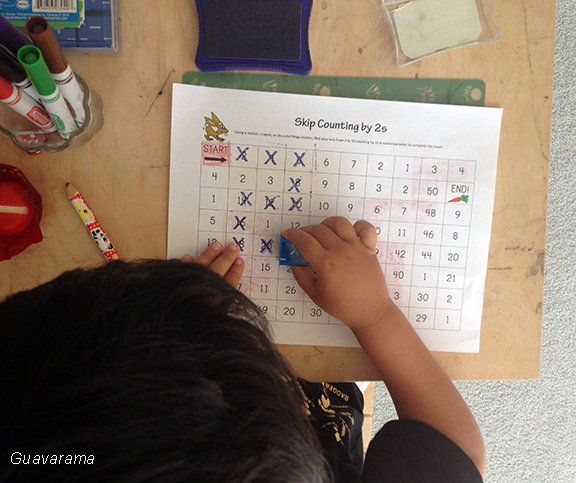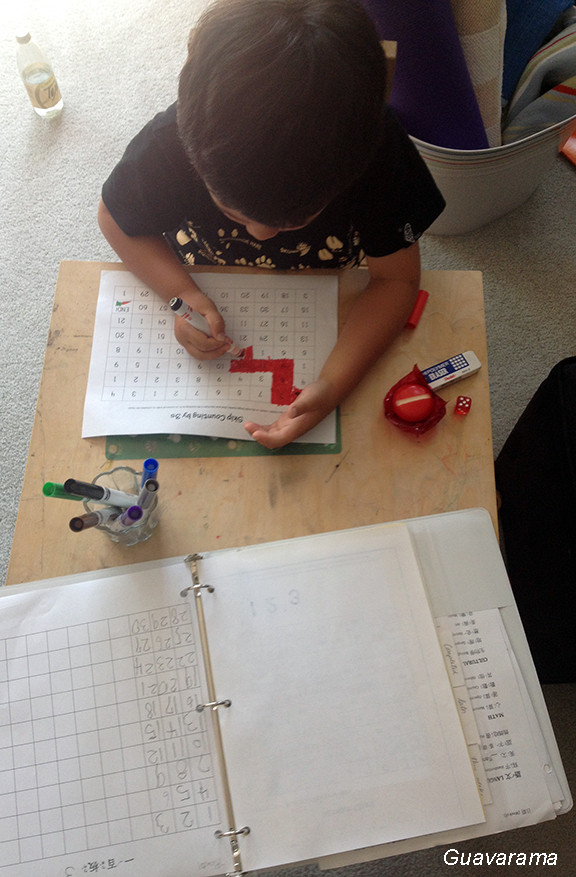Horray for having a curriculum! Sunday night I looked on my presentation calendar and realized I was supposed to present skip counting on Monday. I hurriedly looked at the ideas from What Did We Do All Day and made my own set. She also has a second post on a game you can play. I didn’t even bother doing a bunch of research. We ended up with about 9 ideas from her website. I got both kids to work on them yesterday.
What’s Skip counting?
Skip counting is a state standard for Kindergarten (or it was last year). It is the precursor to learning multiplication and comes after your child has mastered counting. In Montessori, you show the kids how to count these short and long bead chains. The short bead chains are squares of a number, (so for 9, you would be able to count to 81) and the long bead chain are cubes of a number. But you don’t show the kids how to skip! They’re supposed to arrive there on their own after getting tired of counting one by one. Makes sense from a development point of view. It is how you know that they’re ready to move on from counting. Of course in practice I don’t know if it’s really true.
I want to emphasize this because if you teach the trick to skip too early, you could end up with a child who knows how to skip count but not know how to count well. Knowing how to count is important because it helps the child know the relationship between two numbers. It’s the foundation for all math.
I had one epiphany yesterday watching the kids skip count. There are two aspects to multiplication. One is learning your multiples, and the other is knowing the result when two numbers are multiplied together. To me, they’re related but different. So for example, the What Did We Do All Day activities are asking the kids to recite their multiples, for example, 3, 6, 9, 12, etc. But that doesn’t tell me off the top of my head that 12 is 3×4. What it tells me is that 12 is a multiple of 3. Useful when you have to learn Common Multiples.
On the other side is learning your multiplications table. This is what you need when you are doing equations like (1234 x 4321=?) Multiplications table is pure boring memorization. I don’t know of any activities, short of singing, that will make it more fun. Whereas learning multiples there are a variety of activities that I see online.
Where the Kids Were
Last year Thumper got to memorizing 6 and then got stuck, could not remember multiples of 6,7,8,9. I was going to “force” her to continue. Hey, I remember standing next to my mom memorizing them when I was 7, she can do it too! But thankfully I read Life of Fred math. It basically split up what you would normally think of as a complete concept to learn, like learning to add up to 20 all at once, or learning multiplication table up to 9 all at once. Rather, kids have difficulty the bigger the number so they could do well with the beginning numbers (addition up to 10, multiplication up to 5) and then need to wait a year for the rest. So I let it go. This year Thumper is more willing to learn the rest of that multiplication table.
As for Astroboy, he knows his numbers up to 1000 for sure, 10000 sometimes, so we’d been working on counting the bead chains. But I needed more variations. I think the fact that Astroboy is now also adding small numbers together is another good indication that he is ready to figure out the next number in the sequence without counting.
What We Did
I looked through all of the link’s activities and printed them out. I ended up with the following work:
- 選一個數字。 可以丟骰子選。
- 數長的跟短的珠串
- 在一百板上每數到這個數字,用筆塗顏色,念它的乘法表出來。
- 把數字寫下來在空的一百板上,每遇到他的倍數,用新的一行。
- 在珠串復習紙上寫數字。
- 玩迷宮遊戲。
- 看電視,唱九九乘法表歌。
- Astroboy: 寫 數字在空的一百板上。
- 描寫數字。
- Thumper:把20個數字寫在筆記本。
Basically, in English:
- Pick a number, you can use a dice to pick a number. (We ended up picking 2 numbers, one the number to skip count and the other is which # out of the list to work on). Let’s use 3 as an example.
- Count short and long bead chains.
- Skip count on the hundred board by marking every multiple of this number as you count (so mark 3,6,9, etc )
- Write it down on the hundred board, starting a new row each time you reach a multiple. (so 1,2,3 one line, then 4,5,6 second line)
- Write numbers on the short and long bead chains paper (I didn’t make this material yet)
- Play the skip counting maze
- Watch the multiplication table song.
- Write numbers 1-100 on hundred board (mostly for Astroboy to practice counting still)
- Trace numbers. Both kids still need to learn how to write their numbers.
- Write 20 digits consecutively in your notebook. (This is for Thumper to practice writing since I just read the other day tracing doesn’t work too well.
The favorite activity for both kids was the maze I think. That’s all Astroboy wanted to do. Thumper managed some other stuff like tracing.


Notice the writing of multiples on the hundred board paper at bottom of picture. Thumper cheated when she did hers. Though she didn’t know her table well, she added in her head and just wrote down the multiples. I think at this point I may have Thumper really work on memorizing the table, whereas Astroboy will just learn about multiples first.
I found a youtube of the multiplication table in a song in Chinese. Could be boring but the kids like watching videos so hopefully they’ll like it.
Where we got our materials
I followed the link for most of the material. I made my own hundred board so it has Chinese title. The handwriting practice sheet comes from Montessori for Everyone.
